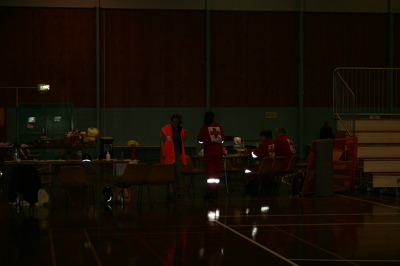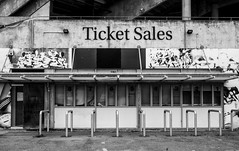
Liquefaction around QEII stadium. The photographer comments, "A Sunday afternoon ride to New Brighton, then back via Aranui, Wainoni, Dallington, and Richmond. Not a cheerful experience. QE2 stadium. View from Frosts Rd".

A photograph of a package full of blankets from the International Federation of Red Cross and Red Crescent Societies, sitting under a table in Cowles Stadium. The stadium served as temporary accommodation for refugees from the 4 September earthquake. These blankets were given to people whose belongings were destroyed or unreachable.

A photograph of members of Red Cross working at the registration table at Cowles Stadium. The stadium was set up as a Civil Defence Report Centre after the 4 September 2010 earthquake.

A page banner promoting an article titled, "Options for AMI Stadium".

A digitally manipulated image of a fuse box. The photographer comments, "This is a fuse box that was in the middle of a field whilst the nearby stadium building was being demolished".

Corrogated roofing from the demolition of the QEII complex. The photographer comments, "This collection of galvanised roofing looks so photogenic as I walked around the partly demolished Queen Elizabeth stadium and swimming pool".

A photograph of volunteers from the Wellington Emergency Management Office working at the reception of the Civil Defence Report Centre set up in Cowles Stadium.

A photograph of members of the Red Cross at the Registration table in Cowles Stadium on Pages Road. The stadium was set up by Civil Defence as temporary accommodation for citizens displayed by the 4 September 2010 earthquake.

An infographic showing the status of AMI Stadium and Rugby League Park.

A photograph of stretchers and blankets set up in Cowles Stadium for people displaced by the 4 September earthquake. In the background a stack of mattresses and a cot can be seen.

A photograph of members of the Red Cross and the Wellington Emergency Management Office organising supplies and temporary accommodation in Cowles Stadium for refugees from the 4 September earthquake.

Under the caption 'Best value for money?' is a football stadium displaying a red cross. From within a voice proclaims the advantages of having a combined covered stadium, hospital and blood bank.
Under CERA, the Christchurch Central Development Unit had planned for a covered sports stadium, with attached facilities and shops as one of the key sites in the Christchurch rebuild after the 2010 and 2011 earthquakes. The 'blood bin' refers to the recent practice in rugby of sending off players with flesh wounds. There were also plans for a new hospital.
Quantity: 1 digital cartoon(s).

A graphic promoting a poll asking for opinions on a proposed stadium design.

An aerial photograph looking over the demolished site of the QE II stadium.

A graphic promoting a poll asking for opinions on a proposed stadium design.

A photograph of two 'All Righties' with a group of young basketball players at Cowles Stadium. All Right? posted the photograph on their Facebook page on 31 July 2014 at 4:48pm.

A photograph of two 'All Righties' promoting the All Right? Winter Survival Kit at Cowles Stadium. All Right? posted the photograph on their Facebook page on 31 July 2014 at 4:48pm.

A photograph of an illuminated All Right? billboard near AMI Stadium. The photograph was used as a cover photo on the All Right? Facebook page on 13 March 2014 at 4:41pm.

A photograph of piles of dirt and gravel outside the ASB Stadium in Wigram.

AMI Stadium (Lancaster Park), not used since the February 2011 earthquake.
It was used predominantly for rugby and cricket.
We are still waiting to see what the outcome is for this stadium. Government want a new one closer to the CBD, so there is talk of this being demolished, while others want it repaired.
The concrete pad lower left is ...

A photograph of street art on the rear wall of Wicked Campers on Ferry Road, taken from Leeds Street. AMI stadium is visible in the background. The photographer believes that the artist may be '007'.

A photograph of street art on the rear wall of Wicked Campers on Ferry Road, taken from Leeds Street. AMI stadium is visible in the background. The photographer believes that the artist may be '007'.

An aerial photograph captioned by BeckerFraserPhotos, "Woolston industrial area. AMI stadium on the left".

Rugby World Cup 2011 (RWC 2011) Tournament partners have reluctantly announced that Christchurch will be unable to host the seven matches currently scheduled to be played at the AMI/Lancater Park Stadium in Christchurch. This follows a detailed assessing of damage to the Stadium, grounds and infrastructure caused by the 6.3 magnitude earthquake ...

A Press Box graphic, featuring an item on the proposal to roof the temporary stadium in Addington.

The layout for a Marshall Lore column featuring an item on the debate over the proposed stadium.

The ticket office at Lancaster Park (AMI Stadium), not used since the February 2011 earthquake. Windows broken and door boarded up.
We are still waiting to see what the outcome is for this stadium. Government want a new one closer to the CBD, so there is talk of this being demolished, while others want it repaired.

The top of the water slides in the QEII swimming pool, exposed by its demolition. The slides themselves have been broken off, leaving only the entry points. The photographer comments, "After assessment of the damage caused by the numerous earthquakes in Christchurch, New Zealand they decided to demolish the QEII stadium and it's swimming pool".

A photograph of members of the Wellington Emergency Management Office lining up outside a Maggi van which is distributing soup. The van is parked outside Cowles Stadium on Pages Road, which was set up by Civil Defence as temporary accommodation for those displaced by the 4 September 2010 earthquake.

The contents page for the Your Weekend section of The Press, featuring a photograph of the damaged AMI Stadium.